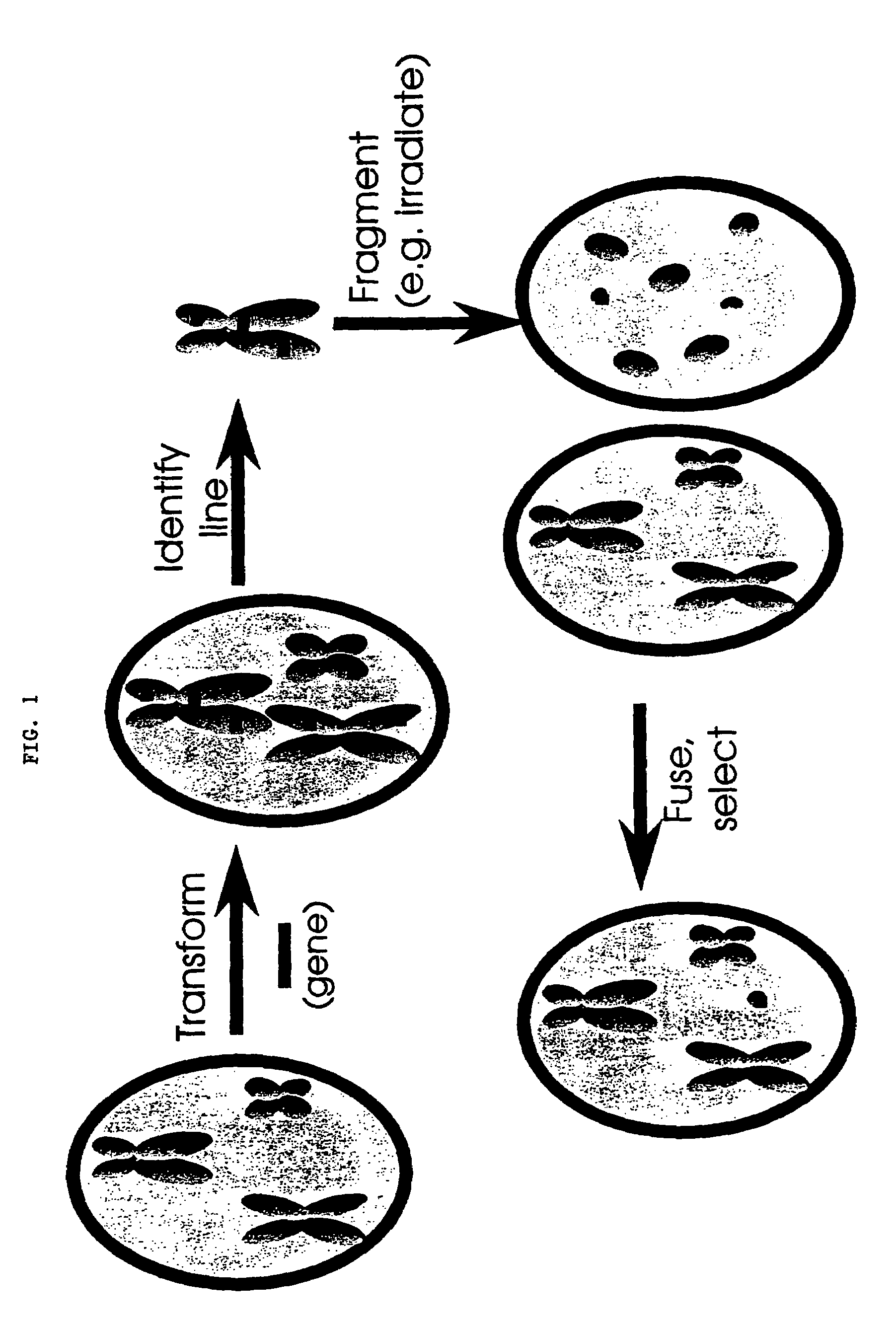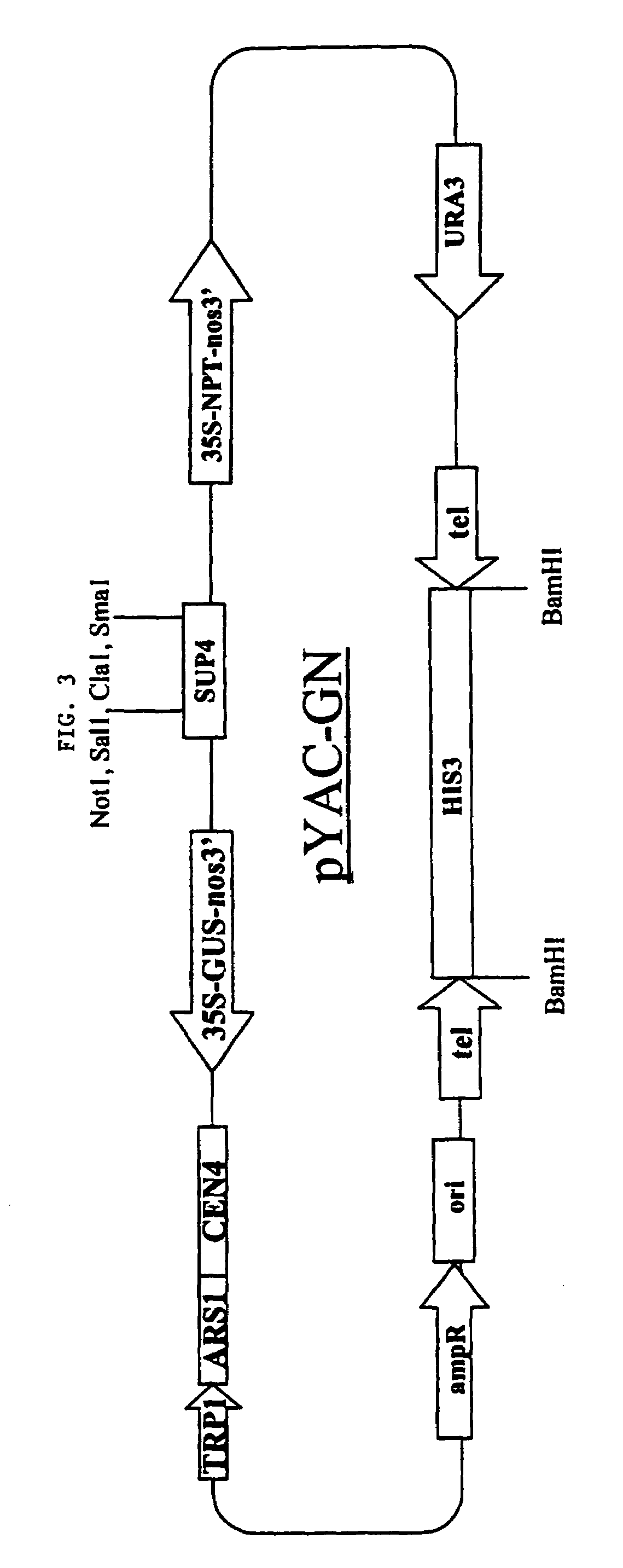Method of making plant artificial chromosomes
a technology of artificial chromosomes and plants, applied in the field of molecular genetics, can solve the problems of limited current methods of plant transformation, severe limitation, and many methods that have limitations
- Summary
- Abstract
- Description
- Claims
- Application Information
AI Technical Summary
Benefits of technology
Problems solved by technology
Method used
Image
Examples
example 1
Evidence for the Production of Stable Chromosome Fragments
[0044]Populations of asymmetric hybrids are produced by fusion with a radiation-inactivated donor. The manipulation of the introduced genetic variation could result in a quicker introgression of a desired trait. Therefore, this technique could be applied in breeding programs. In the asymmetric nuclear hybrids produced between distant and closely related species, the resulting plants were male sterile, even though they appeared to contain only a few chromosomes from the donor partner as shown in Famelaer, et al., Theor. Appl. Genet. 79:513-520 (1990). The scheme presented in FIG. 1 shows the basic strategy applied for the minichromosomes' production in plant cells.
Protoplast Isolation, Fusion, Selection, and Regeneration
[0045]Shoot cultures of the NR-deficient mutant, Nia26, of N. plumbaginifolia (2n 20, reversion frequency 4.04 10-7 (Dirks et al., Mol. Gen. Genet. 179:283-288 (1986)) were cultivated as described by Negrutiu, ...
example 2
Identification of Kanamycin Resistant Plants Following Irradiation and Asymmetric Fusion
Isolation, Fusion and Culture of Protoplasts
[0053]Mesophyll protoplasts were isolated from 4- to 6-week-old plants of N. plumbaginifolia (P2) and kanamycin-resistant Petunia hybrida (transformant VR2828×V23) as described by Negrutiu et al., Theor. Appl. Genet. 72:279-286 (1986). Before fusion kanamycin-resistant Petunia protoplasts were irradiated with gamma rays (100 krad) from a cobalt60 source. Fusions were carried out as described by Menczel et al., Genetics 100:487-495 (1982). The protoplasts were further cultured in K3 medium and subsequently diluted in selection medium (MDn) supplemented with 25 mg / l kanamycin monosulphate. After one to two months, visible calli were transferred to solid selection medium and subsequently regenerated as described by Installe et al., J. Plant Physiol. 119:443-454 (1985). Control experiments were carried out under the same conditions.
Cytological Analysis
[0054...
example 3
Genomic In Situ Hybridization (GISH)
[0064]In the process of producing asymmetric somatic hybrids is necessary to unequivocally identify the alien DNA and recipient genome. Methods used in the past include the analysis chromosomal genes, marker genes, and species-specific repeat sequences. The use of cytogenetic markers to identify chromosomes in chromosomal segments was limited to chromosomes that differed significantly in size or morphology.
[0065]The use of genomic in situ hybridization in which total genomic DNA used as a probe can be used to determine the parental origin of chromosomal material in asymmetric hybrids as described in Parokonny et al., Plant Journal 2:863-874 (1992).
Experimental Procedures:
Plant Material
[0066]Shoot cultures of nitrate reductase-deficient mutants of N. plumbaginifolia (cnx 20 and Nia 26, both with 2n=20), and a chlorophyll-deficient mutant of N. sylvestris CV-42, 2n=24) were cultivated as described by Negrutiu et al. Theor. Appl. Genet. 66:341-347 (1...
PUM
| Property | Measurement | Unit |
|---|---|---|
| concentration | aaaaa | aaaaa |
| pH | aaaaa | aaaaa |
| volume | aaaaa | aaaaa |
Abstract
Description
Claims
Application Information
 Login to View More
Login to View More - R&D
- Intellectual Property
- Life Sciences
- Materials
- Tech Scout
- Unparalleled Data Quality
- Higher Quality Content
- 60% Fewer Hallucinations
Browse by: Latest US Patents, China's latest patents, Technical Efficacy Thesaurus, Application Domain, Technology Topic, Popular Technical Reports.
© 2025 PatSnap. All rights reserved.Legal|Privacy policy|Modern Slavery Act Transparency Statement|Sitemap|About US| Contact US: help@patsnap.com



